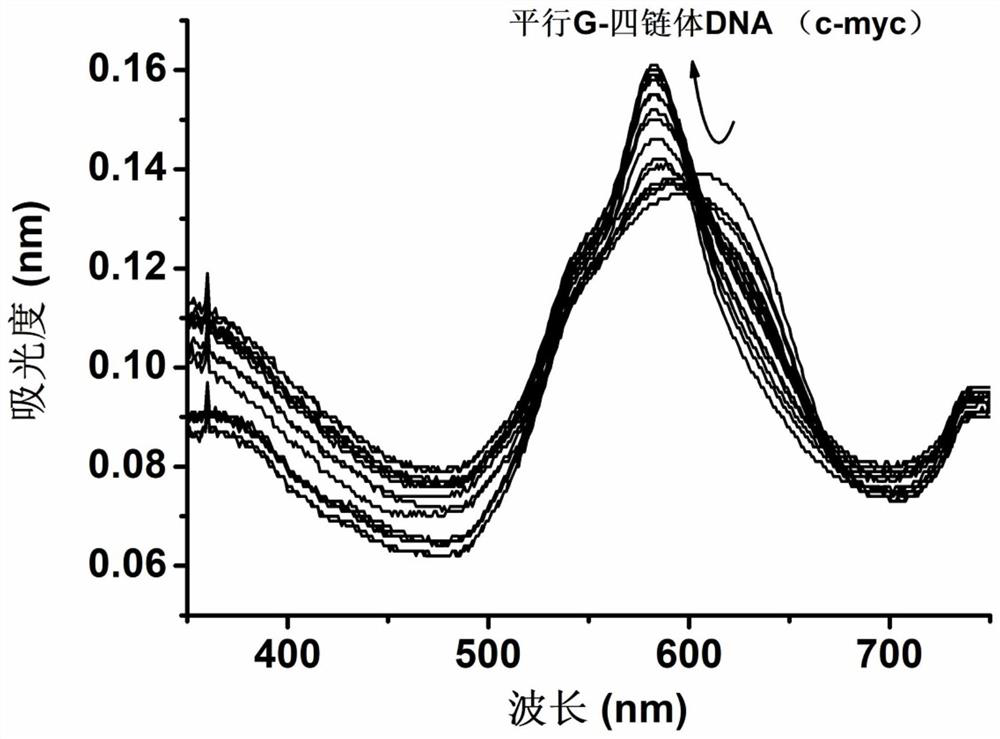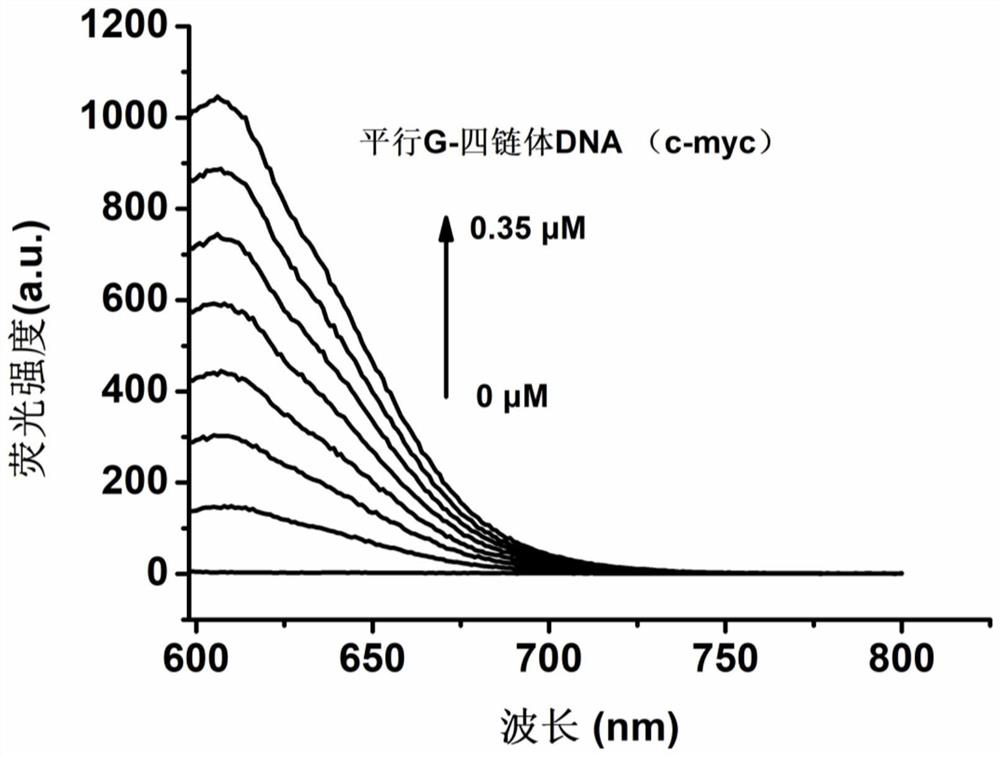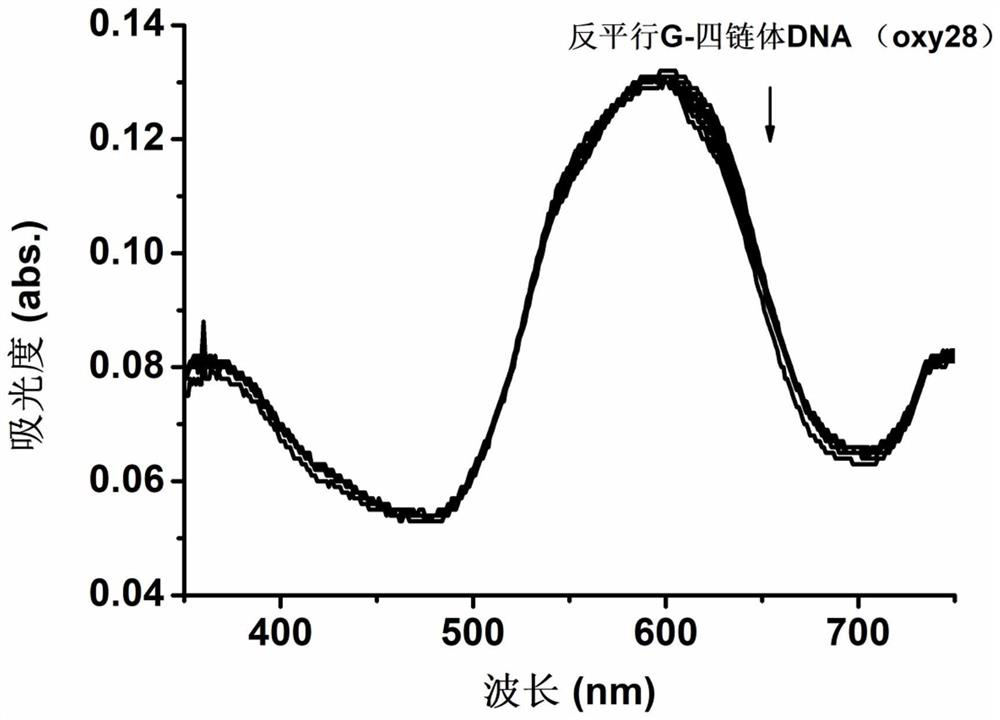A kind of preparation method of specific detection parallel configuration g-quadruplex dna probe
A technology of DNA probes and quadruplexes, applied in the field of biological probes, can solve problems such as single means and large interference, and achieve the effects of easy-to-obtain raw materials, strong operability, and low production costs
- Summary
- Abstract
- Description
- Claims
- Application Information
AI Technical Summary
Problems solved by technology
Method used
Image
Examples
Embodiment 1
[0038] Embodiment 1: the synthesis of compound 3
[0039] Under nitrogen protection, dissolve 1.0 g (3.7 mmol) of p-hydroxybenzaldehyde (compound 1) modified with ether oxygen chains and 0.7 g (7.4 mmol) of 2,4-dimethylpyrrole in 100 mL of anhydrous dichloromethane , add 3-5 drops of catalytic amount of trifluoroacetic acid dropwise, stir at room temperature for 12 hours, then add 0.84g (3.7mmol) 2,3-dichloro-5,6-dicyano-p-benzoquinone, stir for 12 hours, then add 18mL (129mmol) of triethylamine, stirred for 30 minutes, added 15mL (118.0mmol) of boron trifluoride diethyl ether, stirred for 8 hours. Washed successively with ultrapure water (25mL×2 times) and saturated aqueous NaCl solution (25mL×2 times), the obtained organic phase was dried over anhydrous sodium sulfate, dichloromethane was distilled off under reduced pressure, and the obtained crude product was washed with ethyl acetate and petroleum The mixed solvent with ether volume ratio of 1:1 was used as the mobile pha...
Embodiment 2
[0040] Embodiment 2: the synthesis of compound 5
[0041]Dissolve 0.65g (5.0mmol) N-hydroxyethylpiperazine in 50mL of DMSO, add 0.62g (5.0mmol) 4-fluorobenzaldehyde and 2.0g (15.0mmol) K 2 CO 3 The reaction was heated at 100°C in an oil bath for 24 hours. Add 100mL of water after the reaction, and extract with dichloromethane (50mL×3 times), the organic phase obtained is dried over anhydrous sodium sulfate, dichloromethane is distilled off under reduced pressure, and the volume ratio of the resulting crude product to ethyl acetate and petroleum ether is A 2:1 mixed solvent was used as the mobile phase and silica gel was used as the stationary phase for column chromatography purification to obtain 0.80 g of yellow solid product 5 with a yield of 68.3%.
Embodiment 3
[0042] Embodiment 3: the synthesis of probe
[0043] 0.4g (0.82mmol) of compound 3, 0.19g (0.82mmol) of compound 5, 0.8mL of glacial acetic acid and 1mL of piperidine were dissolved in 50mL of toluene, and heated to 120°C for 8 hours. After the reaction, the toluene was evaporated under reduced pressure, and the obtained crude product was purified by column chromatography with a mixed solvent of dichloromethane and methanol in a volume ratio of 20:1 as the mobile phase and silica gel as the stationary phase to obtain 0.21 g of dark blue solid product probe , and the yield was 36.8%. 1 H NMR (400MHz, CDCl 3 )δ: 7.54-7.49(m, 3H), 7.19-7.15(m, 3H), 7.02(d, J=8.24Hz, 2H), 6.88(d, J=8.56Hz, 2H), 6.57(s, 1H ), 5.98(s, 1H), 4.19(t, J=4.28Hz, 2H), 3.91(t, J=4.64Hz, 2H), 3.78-3.76(m, 6H), 3.70-3.66(m, 4H) , 3.57-3.55(m, 2H), 3.38(m, 5H), 2.86(br, 4H), 2.76(m, 2H), 2.57(s, 3H), 1.46(s, 3H), 1.42(s, 3H ); 19 FNMR (376MHz, CDCl 3 )δ: -139.66, -139.73, -139.84, -139.92; HRMS (ESI) m / ...
PUM
 Login to View More
Login to View More Abstract
Description
Claims
Application Information
 Login to View More
Login to View More - R&D
- Intellectual Property
- Life Sciences
- Materials
- Tech Scout
- Unparalleled Data Quality
- Higher Quality Content
- 60% Fewer Hallucinations
Browse by: Latest US Patents, China's latest patents, Technical Efficacy Thesaurus, Application Domain, Technology Topic, Popular Technical Reports.
© 2025 PatSnap. All rights reserved.Legal|Privacy policy|Modern Slavery Act Transparency Statement|Sitemap|About US| Contact US: help@patsnap.com



